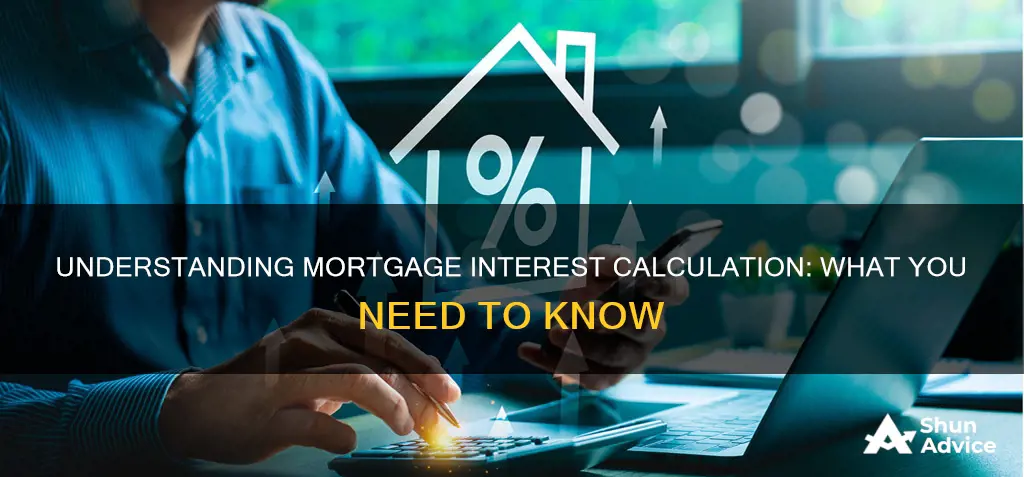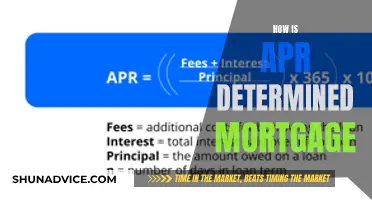
When you take out a mortgage, you pay interest on the amount of the loan that you haven't yet repaid to your lender. The interest is calculated as a percentage of the remaining principal. There are two basic types of mortgages: fixed-rate, in which the interest rate remains the same, and adjustable-rate, in which the interest rate can change over time. Lenders will calculate your interest rate based on your financial situation, including your credit score and other debts.
| Characteristics | Values |
|---|---|
| Interest rate | Depends on the type of loan (fixed or adjustable) and the loan term. |
| Interest calculation | Interest is calculated as a percentage of the remaining principal. |
| Loan amount | The amount of money borrowed, which influences the interest rate and interest paid. |
| Down payment | The upfront payment, usually a percentage of the total price. |
| Loan term | The amount of time over which the loan must be repaid in full. |
| Credit score | Influences the interest rate offered. |
| Debt | Influences the interest rate offered. |
| Other costs | Utilities, home maintenance, property taxes, and insurance. |
| Closing costs | Attorney fees, title service cost, recording fee, survey fee, property transfer tax, etc. |
What You'll Learn

Fixed-rate vs. adjustable-rate mortgages
When you take out a mortgage, you pay interest on the amount of the loan that you haven't yet repaid to your lender. The interest is the cost of borrowing that money. The two basic types of mortgages are fixed-rate and adjustable-rate.
Fixed-Rate Mortgages
With a fixed-rate mortgage, the interest rate is set when you take out the loan and will not change throughout the loan term. This means that your monthly payments will remain the same, providing predictability, which makes budgeting easier. Fixed-rate mortgages are also simpler than adjustable-rate mortgages, making it easier to compare lender offerings.
Adjustable-Rate Mortgages (ARMs)
With an adjustable-rate mortgage (ARMs), the interest rate may go up or down based on broader interest rate trends. The initial interest rate on an ARM is usually below the interest rate on a comparable fixed-rate loan, and this rate may stay the same for months, one year, or a few years. After this initial period, the rate is adjusted at regular intervals until the end of the loan term. The amount of your monthly payment is likely to go up when the index of interest rates increases. ARMs are typically more complicated than fixed-rate mortgages.
Choosing Between Fixed-Rate and Adjustable-Rate Mortgages
When deciding between a fixed-rate and adjustable-rate mortgage, it is important to consider how long you plan to own the home. A fixed-rate mortgage may be a good option if you plan to own the home for a long time, as it offers stable and predictable monthly payments. On the other hand, an ARM might be worth considering if you are looking for lower initial interest rates and monthly payments. However, keep in mind that your payments can increase or decrease over time with an ARM, depending on market conditions.
Reconveyance Wording: Understanding Mortgage Payoff Clauses
You may want to see also

How to calculate principal and interest
When you take out a mortgage, you pay back the amount you borrowed (the principal) plus interest every month. The interest is the cost of borrowing money from a lender. The calculation of interest rates can be complex and depends on a variety of factors, including the type, size, and duration of the loan, as well as the size of your down payment and your credit history.
To calculate the principal of your mortgage loan, subtract your down payment from the purchase price. For example, if you buy a $500,000 home and have a down payment of $80,000, your principal would be $420,000.
Calculating the total interest on your mortgage loan is more complicated than calculating the principal. You can calculate the interest on a simple interest loan by multiplying the principal amount by the interest rate and then multiplying that result by the loan term. However, mortgages are typically amortized loans, which means that you pay more interest at the start of the loan. You can use an online calculator to estimate your monthly mortgage payments, taking into account both the principal and interest.
To calculate your monthly principal payment, subtract the monthly interest payment from your monthly mortgage payment. For example, if your monthly mortgage payment is $2,794 and your monthly interest payment is $2,450, then $344 is going toward your principal each month. You can choose to pay more of your principal loan each month to reduce the amount of interest you accrue over time.
There are two basic types of mortgages: fixed-rate and adjustable-rate. With a fixed-rate mortgage, your monthly payment stays the same for the entire loan term. With an adjustable-rate mortgage, the interest rate starts with a fixed rate for a set period and then adjusts at regular intervals based on market conditions, causing your monthly payment to increase or decrease.
Understanding DTI: The Key to Unlocking Your Dream Mortgage
You may want to see also

How to get a lower interest rate
When you take out a mortgage, you pay interest on the amount of the loan that you haven't yet repaid. The interest is calculated as a percentage of the remaining principal. The higher the interest rate, the more you will pay over the life of the loan. Here are some ways to get a lower interest rate:
Shop around for a lower interest rate
You don't have to get your mortgage from your bank. Compare offers from a few lenders to help you find the lowest rates. Getting multiple quotes can save you money. According to Freddie Mac, getting two quotes can save an average of $1,500, while getting four quotes can save around $5,000 over the life of a loan.
Improve your credit score
Lenders will calculate your interest rate based on your personal financial situation, including your credit score. Improving your credit score can help you qualify for a lower rate. Even a small increase can make a big difference.
Make a bigger down payment
The bigger your down payment, the lower your loan-to-value ratio (LTV) and, in general, the lower your mortgage rate. For example, if you make a 20% down payment, your LTV is 80%.
Choose a shorter loan term
A shorter loan term will usually have a lower interest rate than a longer one. For example, a 15-year mortgage often has lower interest rates than a 30-year mortgage. However, your monthly payments will be higher as you'll have less time to pay it off.
Prepay your interest
You can prepay interest to lower your ongoing mortgage rate, which is known as buying discount points. Each discount point costs 1% of your loan size and typically lowers your rate by 0.25 percentage points.
Choose an adjustable-rate mortgage
Adjustable-rate mortgages (ARMs) often have introductory rates below the market. They have a fixed rate for a set number of years, usually between one and seven, before adjusting at regular intervals. However, this can be risky because you'll have to pay more if rates rise.
Understanding Your Mortgage: Final Payoff Calculation Explained
You may want to see also

How to calculate monthly payments
Calculating your monthly mortgage payments is a complex process that depends on a variety of factors. Firstly, you need to understand the two components of a mortgage payment: the principal and the interest. The principal is the original loan amount you borrow, excluding any interest. The interest is the amount charged by the lender for lending you the money. This is calculated as a percentage of the remaining principal.
To calculate your monthly payments, you will need to know the market value of the home you want to purchase. You will also need to consider the loan's interest rate, which fluctuates with the market and is influenced by factors such as the economic climate, interest rates set by the Federal Reserve, and your personal financial situation. Generally, borrowers with higher credit scores tend to secure lower interest rates.
You can use the following formula to calculate the monthly payment:
> c = rP / (1 - (1 + r)^-N)
In this formula, c represents the monthly payment, r is the monthly interest rate (the yearly rate divided by 12), P is the amount borrowed (the principal), and N is the total number of payments.
For example, let's say you borrow $200,000 at a fixed yearly interest rate of 6.5% for 30 years. Using the formula, we can calculate the monthly payment as follows:
> c = 0.065/12 * 200000 / (1 - (1 + 0.065/12)^-30) = $1,264.81
So, the monthly payment for this mortgage would be $1,264.81.
It's important to note that this calculation assumes a fixed-rate mortgage, where the interest rate remains constant throughout the loan term. For adjustable-rate mortgages, the interest rate can change over time, making the calculation more complex.
Additionally, there are online mortgage calculators available that can help you estimate your monthly payments. These calculators can take into account various factors, such as your income, other debts, property taxes, and insurance costs. Using these tools can provide you with a more accurate estimate of your monthly mortgage payments.
Paying Off My Mortgage: Strategies for Faster Freedom
You may want to see also

How to pay off a mortgage early
When you take out a mortgage, you pay interest on the amount of the loan that you haven't yet repaid to your lender. This interest is the cost of borrowing money. The interest is calculated as a percentage of the remaining principal (the amount you borrowed that you haven't yet paid back). The longer you have a mortgage, the more interest you will pay over the life of the loan.
- Making extra payments towards your principal balance will help you save money on interest and pay off your loan faster. You can use a budgeting tool to see how extra mortgage payments fit into your budget.
- If you are considering making extra payments on your mortgage, be aware that some mortgage loans have prepayment penalties. Many do not, but it is important to check with your lender.
- You can reduce the size of your loan by making a bigger down payment.
- Shop around for a lower interest rate. You don't have to get your mortgage from your bank. Comparing offers from a few lenders can help you find the lowest rates.
- Choose a shorter loan term. With a shorter term, your monthly payment will be higher, but you will pay less interest over the life of the loan.
The High Cost of Mansion Mortgages: Average or Exception?
You may want to see also
Frequently asked questions
A mortgage is a loan taken to buy a home.
The principal is the original loan amount you borrow, not including any interest. The interest is the amount the bank or lender charges for lending you the money.
Lenders calculate the interest rate based on your personal financial situation, such as your credit score, debt, income, and down payment.
The interest on a mortgage is calculated by multiplying the principal amount by the interest rate, then multiplying that by the number of years of the loan term. Banks calculate interest on your loan amount daily.
You can get a lower interest rate by improving your credit score, paying down debt, making a larger down payment, or shopping around for a better interest rate.







